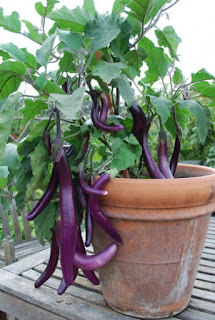Posted by: Patti O'Neal, Jefferson County Extension
Not all of us have the space, the time, the know-how or the
confidence to start growing all our own food.
But there is an easy, much less overwhelming solution, a way to get started;
grow a container garden.
Advantages of Container Food Gardens
- · They reduce the effort of nearly every garden task, apart from watering which requires more diligence.
- · They are mobile and can be placed or moved to take advantage of orientation to light.
- · You avoid most all soil borne diseases
- · Pretty much guaranteed weed free
- · Allow for creative expression with vegetables, herbs and edible flowers
Choosing
seeds or Transplants
When starting out, look for varieties with the words “Bush”
or “Patio” or “Dwarf” or “Determinate” in the name for the surest way to find a
variety best adapted to container culture.
After a season or two when you are comfortable with growing this way,
opt for anything and experiment with trellising for vining crops.
Light and Orientation
Most all vegetables need 7-8 hours of full sun to give best
harvest. But some, like leafy greens
will succeed with as little as 4, with some root vegetables succeeding with 6. Balconies, patios, yards with south, east facing
exposures are best with west good with added protection in the heat of the day.
North facing areas are far less
successful but can handle leafy green vegetables and some root crops if
unobstructed light. Always worth trying.
Containers
Select containers that provide adequate root space, for root
crops. The container should hold adequate soil to support the mature size of
the plant. It should have adequate
drainage. The larger the container the
more drainage there should be. Consider
the root growth as some plants require much less than others and therefore a shallower
container might be right for the job. Refer to CMG Garden Notes https://cmg.extension.colostate.edu/Gardennotes/724.pdf
for complete list of container vegetables and the size container adequate for
good growth.
Soil
Container Mix or Outdoor Container Mix or Potting Soil are
clean and contain enough mineral to sustain good growth with a good
fertilization program. Do not use garden
soil in a container as it contains soil borne diseases and pests which can wreak
havoc in a small space. Nor does it
drain well. Seed starting mix contains
no soil at all and will not sustain the root growth of vegetable plants.
Watering
Vegetables need adequate and consistent water. Inconsistent water will encourage both
disease and pest problems. Inadequate
water will yield stringy, tough and even bitter flavored vegetables. It is particularly critical to monitor
watering of vegetables in containers as they have a limited soil mass. The smaller the container the more watering
may be required each day in the heat of summer.
Larger containers will require less.
Watering can be done by hand, or there are excellent drip systems that
can be set up for containers. When you
water, you should apply enough so that the excess drains out. If using drip dishes, these should be emptied
of any excess after15-20 minutes. Turkey
Fertilizer
Vegetables are annuals and thus are heavy feeders. Timed release fertilizer can be added to soil
at the root level when planting. Use a soluble
fertilizer according to the label directions.
But be cautious. Excessive
fertilizer (nitrogen) will force green growth at the expense of fruit set. Likewise,
over fertilizing herbs causes forced growth at the expense of volatile oils.
Plantings
Be creative with your plantings. You can mix varieties of the same plant for
color and texture or to try new things.
Mix herbs and edible flowers with your vegetables to make the container
more interesting and serviceable.
Growing your own food is satisfying and rewarding. If you want to try your hand at self-sufficiency
but have been hesitant for lack of space or confidence, starting a small Victory
garden is the way to go. You can add
containers as your confidence builds and try new vegetables or varieties of one
you particularly love. Containers are a
great way to involve children in first time gardening as well as they are
easier to plant, tend and harvest. So,
don’t let space or confidence stop you.
Claim Victory! Start a Victory
Vegetable Container Garden.





I absolutely love this article. I have converted all my patio containers to growing food instead of flowers: swiss chard, green onions, shallots, spinach, lettuce and radishes. I'm over sixty and I don't want to go to the grocery store in May for fresh vegetables. I have a plan for warm season vegetables to replace them (succession gardening). I sent this to all my friends. Thank you?
ReplyDeleteThis comment has been removed by a blog administrator.
DeleteSounds fabulous, Kathy. Thanks for sending it on and encouraging all your friends to grow veggies too.
Delete